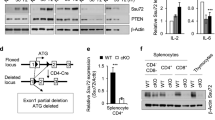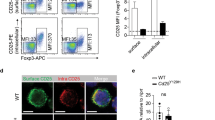Abstract
Regulatory T cells (Treg cells) are critically involved in maintaining immunological tolerance, but this potent suppression must be 'quenched' to allow the generation of adaptive immune responses. Here we report that sphingosine 1-phosphate (S1P) receptor type 1 (S1P1) delivers an intrinsic negative signal to restrain the thymic generation, peripheral maintenance and suppressive activity of Treg cells. Combining loss- and gain-of-function genetic approaches, we found that S1P1 blocked the differentiation of thymic Treg precursors and function of mature Treg cells and affected Treg cell–mediated immune tolerance. S1P1 induced selective activation of the Akt-mTOR kinase pathway to impede the development and function of Treg cells. Dynamic regulation of S1P1 contributed to lymphocyte priming and immune homeostasis. Thus, by antagonizing Treg cell–mediated immune suppression, the lipid-activated S1P1-Akt-mTOR pathway orchestrates adaptive immune responses.
This is a preview of subscription content, access via your institution
Access options
Subscribe to this journal
Receive 12 print issues and online access
$209.00 per year
only $17.42 per issue
Buy this article
- Purchase on Springer Link
- Instant access to full article PDF
Prices may be subject to local taxes which are calculated during checkout








Similar content being viewed by others
References
Sakaguchi, S., Yamaguchi, T., Nomura, T. & Ono, M. Regulatory T cells and immune tolerance. Cell 133, 775–787 (2008).
Zheng, Y. & Rudensky, A.Y. Foxp3 in control of the regulatory T cell lineage. Nat. Immunol. 8, 457–462 (2007).
Campbell, D.J. & Ziegler, S.F. FOXP3 modifies the phenotypic and functional properties of regulatory T cells. Nat. Rev. Immunol. 7, 305–310 (2007).
Tang, Q. & Bluestone, J.A. The Foxp3+ regulatory T cell: a jack of all trades, master of regulation. Nat. Immunol. 9, 239–244 (2008).
Shevach, E.M. et al. The lifestyle of naturally occurring CD4+CD25+Foxp3+ regulatory T cells. Immunol. Rev. 212, 60–73 (2006).
Fontenot, J.D., Rasmussen, J.P., Gavin, M.A. & Rudensky, A.Y. A function for interleukin 2 in Foxp3-expressing regulatory T cells. Nat. Immunol. 6, 1142–1151 (2005).
Liu, Y. et al. A critical function for TGF-β signaling in the development of natural CD4+CD25+Foxp3+ regulatory T cells. Nat. Immunol. 9, 632–640 (2008).
Vignali, D.A., Collison, L.W. & Workman, C.J. How regulatory T cells work. Nat. Rev. Immunol. 8, 523–532 (2008).
Pasare, C. & Medzhitov, R. Toll pathway-dependent blockade of CD4+CD25+ T cell-mediated suppression by dendritic cells. Science 299, 1033–1036 (2003).
Yang, Y., Huang, C.T., Huang, X. & Pardoll, D.M. Persistent Toll-like receptor signals are required for reversal of regulatory T cell-mediated CD8 tolerance. Nat. Immunol. 5, 508–515 (2004).
Peng, G. et al. Toll-like receptor 8-mediated reversal of CD4+ regulatory T cell function. Science 309, 1380–1384 (2005).
Sutmuller, R.P. et al. Toll-like receptor 2 controls expansion and function of regulatory T cells. J. Clin. Invest. 116, 485–494 (2006).
Liu, H., Komai-Koma, M., Xu, D. & Liew, F.Y. Toll-like receptor 2 signaling modulates the functions of CD4+CD25+ regulatory T cells. Proc. Natl. Acad. Sci. USA 103, 7048–7053 (2006).
Schwab, S.R. & Cyster, J.G. Finding a way out: lymphocyte egress from lymphoid organs. Nat. Immunol. 8, 1295–1301 (2007).
Rosen, H. et al. Modulating tone: the overture of S1P receptor immunotherapeutics. Immunol. Rev. 223, 221–235 (2008).
Rivera, J., Proia, R.L. & Olivera, A. The alliance of sphingosine-1-phosphate and its receptors in immunity. Nat. Rev. Immunol. 8, 753–763 (2008).
Mandala, S. et al. Alteration of lymphocyte trafficking by sphingosine-1-phosphate receptor agonists. Science 296, 346–349 (2002).
Brinkmann, V. et al. The immune modulator FTY720 targets sphingosine 1-phosphate receptors. J. Biol. Chem. 277, 21453–21457 (2002).
Matloubian, M. et al. Lymphocyte egress from thymus and peripheral lymphoid organs is dependent on S1P receptor 1. Nature 427, 355–360 (2004).
Allende, M.L., Dreier, J.L., Mandala, S. & Proia, R.L. Expression of the sphingosine 1-phosphate receptor, S1P1, on T-cells controls thymic emigration. J. Biol. Chem. 279, 15396–15401 (2004).
Chi, H. & Flavell, R.A. Cutting edge: regulation of T cell trafficking and primary immune responses by sphingosine 1-phosphate receptor 1. J. Immunol. 174, 2485–2488 (2005).
Graler, M.H., Huang, M.C., Watson, S. & Goetzl, E.J. Immunological effects of transgenic constitutive expression of the type 1 sphingosine 1-phosphate receptor by mouse lymphocytes. J. Immunol. 174, 1997–2003 (2005).
Ishii, I., Fukushima, N., Ye, X. & Chun, J. Lysophospholipid receptors: signaling and biology. Annu. Rev. Biochem. 73, 321–354 (2004).
Sawicka, E. et al. The sphingosine 1-phosphate receptor agonist FTY720 differentially affects the sequestration of CD4+/CD25+ T-regulatory cells and enhances their functional activity. J. Immunol. 175, 7973–7980 (2005).
Fontenot, J.D., Dooley, J.L., Farr, A.G. & Rudensky, A.Y. Developmental regulation of Foxp3 expression during ontogeny. J. Exp. Med. 202, 901–906 (2005).
Lio, C.W. & Hsieh, C.S. A two-step process for thymic regulatory T cell development. Immunity 28, 100–111 (2008).
Burchill, M.A. et al. Linked T cell receptor and cytokine signaling govern the development of the regulatory T cell repertoire. Immunity 28, 112–121 (2008).
Fontenot, J.D. et al. Regulatory T cell lineage specification by the forkhead transcription factor foxp3. Immunity 22, 329–341 (2005).
Powrie, F., Correa-Oliveira, R., Mauze, S. & Coffman, R.L. Regulatory interactions between CD45RBhigh and CD45RBlow CD4+ T cells are important for the balance between protective and pathogenic cell-mediated immunity. J. Exp. Med. 179, 589–600 (1994).
Theofilopoulos, A.N., Koundouris, S., Kono, D.H. & Lawson, B.R. The role of IFN-γ in systemic lupus erythematosus: a challenge to the Th1/Th2 paradigm in autoimmunity. Arthritis Res. 3, 136–141 (2001).
Fontenot, J.D., Gavin, M.A. & Rudensky, A.Y. Foxp3 programs the development and function of CD4+CD25+ regulatory T cells. Nat. Immunol. 4, 330–336 (2003).
Sauer, S. et al. T cell receptor signaling controls Foxp3 expression via PI3K, Akt, and mTOR. Proc. Natl. Acad. Sci. USA 105, 7797–7802 (2008).
Haxhinasto, S., Mathis, D. & Benoist, C. The AKT-mTOR axis regulates de novo differentiation of CD4+Foxp3+ cells. J. Exp. Med. 205, 565–574 (2008).
Knight, Z.A. et al. A pharmacological map of the PI3-K family defines a role for p110α in insulin signaling. Cell 125, 733–747 (2006).
Nombela-Arrieta, C. et al. A central role for DOCK2 during interstitial lymphocyte motility and sphingosine-1-phosphate-mediated egress. J. Exp. Med. 204, 497–510 (2007).
Carlson, C.M. et al. Kruppel-like factor 2 regulates thymocyte and T-cell migration. Nature 442, 299–302 (2006).
Miyara, M. & Sakaguchi, S. Natural regulatory T cells: mechanisms of suppression. Trends Mol. Med. 13, 108–116 (2007).
Ledgerwood, L.G. et al. The sphingosine 1-phosphate receptor 1 causes tissue retention by inhibiting the entry of peripheral tissue T lymphocytes into afferent lymphatics. Nat. Immunol. 9, 42–53 (2008).
Belkaid, Y., Piccirillo, C.A., Mendez, S., Shevach, E.M. & Sacks, D.L. CD4+CD25+ regulatory T cells control Leishmania major persistence and immunity. Nature 420, 502–507 (2002).
Lund, J.M., Hsing, L., Pham, T.T. & Rudensky, A.Y. Coordination of early protective immunity to viral infection by regulatory T cells. Science 320, 1220–1224 (2008).
Takabe, K., Paugh, S.W., Milstien, S. & Spiegel, S. “Inside-out” signaling of sphingosine-1-phosphate: therapeutic targets. Pharmacol. Rev. 60, 181–195 (2008).
Bensinger, S.J. et al. Distinct IL-2 receptor signaling pattern in CD4+CD25+ regulatory T cells. J. Immunol. 172, 5287–5296 (2004).
Crellin, N.K., Garcia, R.V. & Levings, M.K. Altered activation of AKT is required for the suppressive function of human CD4+CD25+ T regulatory cells. Blood 109, 2014–2022 (2007).
Sehrawat, S. & Rouse, B.T. Anti-inflammatory effects of FTY720 against viral-induced immunopathology: role of drug-Induced conversion of T cells to become Foxp3+ regulators. J. Immunol. 180, 7636–7647 (2008).
Daniel, C. et al. FTY720 ameliorates Th1-mediated colitis in mice by directly affecting the functional activity of CD4+CD25+ regulatory T cells. J. Immunol. 178, 2458–2468 (2007).
Payne, S.G. et al. The immunosuppressant drug FTY720 inhibits cytosolic phospholipase A2 independently of sphingosine-1-phosphate receptors. Blood 109, 1077–1085 (2007).
Wan, Y.Y., Chi, H., Xie, M., Schneider, M.D. & Flavell, R.A. The kinase TAK1 integrates antigen and cytokine receptor signaling for T cell development, survival and function. Nat. Immunol. 7, 851–858 (2006).
Mitchell, T.C. et al. Immunological adjuvants promote activated T cell survival via induction of Bcl-3. Nat. Immunol. 2, 397–402 (2001).
Menon, S. et al. COP9 signalosome subunit 8 is essential for peripheral T cell homeostasis and antigen receptor-induced entry into the cell cycle from quiescence. Nat. Immunol. 8, 1236–1245 (2007).
Acknowledgements
We thank A. Rudensky (University of Washington) for Foxp3gfp 'knock-in' mice; D. Hildeman (University of Cincinnati) for dominant negative and constitutively active Akt retroviral constructs; S. Shrestha for help with genotyping; M. McGargill for help with the FTOC procedure; R. Cross and G. Lennon for cell sorting; and D. Green and D. Vignali for scientific discussions and reagents. Supported by the US National Institutes of Health (H.C.), the Arthritis Foundation (H.C.), the Arthritis National Research Foundation (H.C.), the American Lebanese Syrian Associated Charities (H.C.) and the Intramural Research Program of the National Institutes of Health, National Institute of Diabetes and Digestive and Kidney Diseases (R.L.P.).
Author information
Authors and Affiliations
Contributions
G.L. designed and did the experiments with cells and mice, analyzed data and contributed to writing the manuscript; S.B. did retroviral transduction of bone marrow cells and reconstitution and managed the mouse colony; G.H. and S.B. contributed to real-time PCR analysis; K.B. analyzed and assigned scores to histology data; R.L.P. and R.A.F. provided animal models; and H.C. designed experiments, analyzed data, wrote the manuscript and provided overall direction.
Corresponding author
Supplementary information
Supplementary Text and Figures
Supplementary Figures 1–19 (PDF 3117 kb)
Rights and permissions
About this article
Cite this article
Liu, G., Burns, S., Huang, G. et al. The receptor S1P1 overrides regulatory T cell–mediated immune suppression through Akt-mTOR. Nat Immunol 10, 769–777 (2009). https://doi.org/10.1038/ni.1743
Received:
Accepted:
Published:
Issue Date:
DOI: https://doi.org/10.1038/ni.1743
This article is cited by
-
The role of sphingosine-1-phosphate in autophagy and related disorders
Cell Death Discovery (2023)
-
Functional roles of sphingolipids in immunity and their implication in disease
Experimental & Molecular Medicine (2023)
-
Visualizing Sphingosine-1-Phosphate Receptor 1(S1P1) Signaling During Central Nervous System De- and Remyelination
Cellular and Molecular Neurobiology (2023)
-
Sphingosine 1-phosphate receptor-targeted therapeutics in rheumatic diseases
Nature Reviews Rheumatology (2022)
-
The effect of fingolimod on regulatory T cells in a mouse model of brain ischaemia
Journal of Neuroinflammation (2021)



